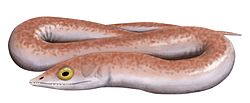| Papposaurus | |
|---|---|
| Scientific classification | |
| Domain: | Eukaryota |
| Kingdom: | Animalia |
| Phylum: | Chordata |
| Clade: | Sarcopterygii |
| Clade: | Tetrapodomorpha |
| Order: | † Embolomeri |
| Family: | † Proterogyrinidae |
| Genus: | † Papposaurus Watson, 1914 |
| Type species | |
| Papposaurus traquairi Watson, 1914 | |
Papposaurus is an extinct genus of proterogyrinid embolomere which lived in the Mississippian (early Carboniferous) of Scotland. It is known from a single species, Papposaurus traquiairi, which is based on an isolated femur discovered in ironstone near Loanhead. [1] [2] Though originally compared closely to reptiles, [3] subsequent study has revealed closer similarity to basal embolomeres such as Proterogyrinus and Archeria . [1] With such limited remains, Papposaurus may not be a valid genus. The femur was redescribed in 1986 by T. R. Smithson, who considered Papposaurus traquairi a nomen vanum possibly synonymous with Proterogyrinus scheelei. [4]





